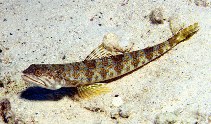| Family: |
Synodontidae (Lizardfishes), subfamily: Synodontinae |
| Max. size: |
46 cm TL (male/unsexed); max.weight: 1,000.0 g |
| Environment: |
reef-associated; marine; depth range 3 - 320 m |
| Distribution: |
Western Atlantic: Bermuda, North Carolina (USA) and northern Gulf of Mexico to Santa Catarina, Brazil (Ref. 57756). Most common lizard fish in the West Indies (Ref. 13442). |
| Diagnosis: |
Dorsal spines (total): 0-0; Dorsal soft rays (total): 11-12; Anal spines: 0-0; Anal soft rays: 11-11; Vertebrae: 49-52. This species is distinguished by the following characters: D rays 11-12; A rays 11; total caudal rays 40-42; dorsal segmented caudal rays 9; ventral segmented caudal rays 9-10; dorsal procurrent caudal rays 11-12; ventral procurrent caudal rays 9-10; pelvic-fin rays 8; pectoral-fin rays 11-13; total vertebrae 49-52 (modally 50); pored lateral-line scales 49-52 (modally 51); median predorsal scales 16-17; scale rows on cheek 6-8; HL 15.2-28.4% SL (26.6%); orbit diameter 3.6-6.4% SL (4.7%) and 13.4-22.5% HL (17.2%); interorbital width 2.8-5.3% SL (4.3%) and 10.1-19.4% HL (15.9%); flap on anterior nostril is small and broad, its length 1.5-3.6% HL (2.4%); snout triangular in dorsal view; pelvic-fin length 23.1-26.7% SL (24.9%); when preserved, 3-6 dark bars on caudal fin spanning upper and lower lobes; with a small, rectangular-shaped, black scapular blotch (length 5.1-12.2% HL, mean 8.4%); there are 9-13 dark bars on trunk; colour in life, adults tan to olive and with unevenly distributed yellow stripes along body (Ref. 93218). |
| Biology: |
Found on the sandy bottom around boulders or in sandy corridors in patch reefs (Ref. 5521). Uncommon near the shore. |
| IUCN Red List Status: |
Least Concern (LC); Date assessed: 29 January 2013 Ref. (130435)
|
| Threat to humans: |
harmless |
Source and more info: www.fishbase.org. For personal, classroom, and other internal use only. Not for publication.
